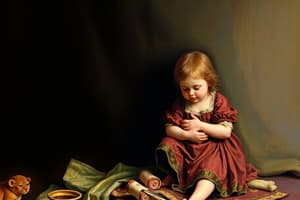Podcast
Questions and Answers
What is the definition of acts by a caregiver that cause harm to a child?
What is the definition of acts by a caregiver that cause harm to a child?
- Emotional support and care for the child
- Causing physical harm or having the potential for harm (correct)
- Supervising the child's daily activities
- Providing educational resources for the child
What is a common sign of non-accidental physical injury in a child?
What is a common sign of non-accidental physical injury in a child?
- Improved confidence
- Increased appetite
- Unexplained bruises, bites, or broken bones (correct)
- Unexplained weight gain
What is the term used to describe the clinical manifestations of serious physical abuse in young children?
What is the term used to describe the clinical manifestations of serious physical abuse in young children?
- Battered child syndrome (correct)
- Physical abuse disorder
- Child abuse syndrome
- Child harm syndrome
What is a behavioral sign of a child who is experiencing physical abuse?
What is a behavioral sign of a child who is experiencing physical abuse?
What might a child who is experiencing physical abuse do when it is time to go home?
What might a child who is experiencing physical abuse do when it is time to go home?
Flashcards are hidden until you start studying
Study Notes
Child Abuse
- Acts by a caregiver that cause physical harm or have the potential to harm the child.
- Non-accidental physical injury of a child, including:
- Unexplained burns, bites, bruises, broken bones, or black eyes
- Fading bruises or other marks
Behavioral Signs of Child Abuse
- Child seems frightened of the parents and protests or cries when it is time to go home
- Child shrinks at the approach of an adult
- Child reports injury by a parent or caregiver
Battered Child Syndrome
- Term coined by Kempe et al. (1962) to describe the clinical manifestations of serious physical abuse in young children
Studying That Suits You
Use AI to generate personalized quizzes and flashcards to suit your learning preferences.




